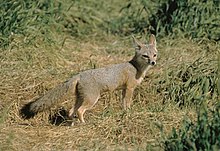| San Joaquin kit fox | |
|---|---|

| |
| Male San Joaquin kit fox | |
| Scientific classification | |
| Domain: | Eukaryota |
| Kingdom: | Animalia |
| Phylum: | Chordata |
| Class: | Mammalia |
| Order: | Carnivora |
| Family: | Canidae |
| Genus: | Vulpes |
| Species: | |
| Subspecies: | V. m. mutica
|
| Trinomial name | |
| Vulpes macrotis mutica Merriam, 1902
| |
The San Joaquin kit fox (Vulpes macrotis mutica) is an endangered species of fox that was formerly very common in the San Joaquin Valley and much of Central California. As an opportunistic hunter, the San Joaquin kit fox primarily preys on kangaroo rats but also targets white-footed mice, pocket mice, ground squirrels, rabbits, and ground-nesting birds. During certain times of the year, especially when other food sources might be scarce, it will also consume insects. Its 1990 population was estimated to be 7,000. This subspecies is still endangered, after nearly 50 years of being on the Endangered Species List. Officially this subspecies was listed March 3, 1967.[1] On September 26, 2007, Wildlands Inc. announced the designation of the 684-acre (2.77 km2) Deadman Creek Conservation Bank, which is intended specifically to protect habitat of the San Joaquin kit fox.[2] However, the population continues to decline mostly due to heavy habitat loss. Other factors include competition from red fox, and the extermination of the gray wolf from California has left the coyote as the dominant meso-predator in kit fox territory bringing an imbalance in ecosystem relationships. Sarcoptic mange has also constituted a significant threat, specifically to the Bakersfield population of the subspecies, with 15 confirmed cases reported by the end of 2014.[3]
- ^ "Species Profile for San Joaquin Kit fox (Vulpes macrotis mutica)". ecos.fws.gov. Archived from the original on 2011-10-15.
- ^ Kit fox Gets Some Protection, In California, Environmental News Network, September 27, 2007
- ^ Brian L. Cypher; Jaime L. Rudd; Tory L. Westall; Leslie W. Woods; Nicole Stephenson; Janet E. Foley; Donald Richardson; Deana L. Clifford (2017-01-01). "Sarcoptic Mange in Endangered Kit Foxes (Vulpes Macrotis Mutica): Case Histories, Diagnoses, and Implications for Conservation". Journal of Wildlife Diseases. 53 (1): 46–53. doi:10.7589/2016-05-098. PMID 27669012. S2CID 24716194.
